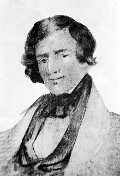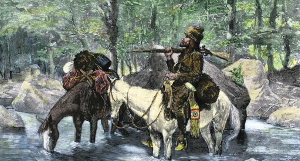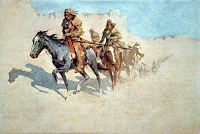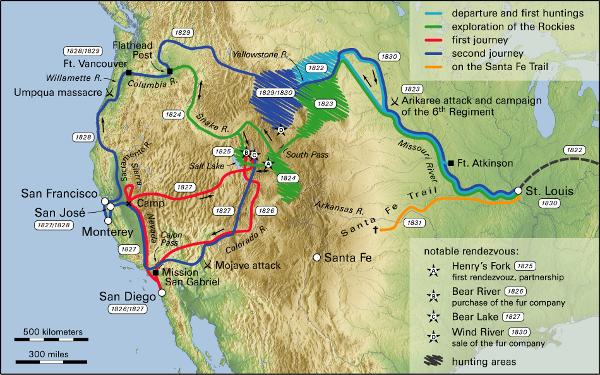Jedediah Smith: Famous Mountain Man and Trapper
Jedediah Smith was one of America's first famous Mountain Men, helping others cross the great expanse of the uncharted West. He claimed many firsts, including surviving a crossing of the deadly Mojave Desert. 
Smith was born on Jan. 6, 1799, at Bainbridge, in New York's Susquehanna Valley. His family moved to Erie, Pa., when young Jedediah was 10. Titus Simons, a doctor there, helped the young man with his education, in part by giving him a copy of the report written after the Lewis and Clark expedition. Another family move brought them to what was then the frontier, what is now Ohio. Jedediah, of age, set himself on a course further west. He reached St. Louis, the famous outpost from which the Lewis and Clark expedition had begun. He joined the burgeoning North American fur trade, answering the same newspaper ad that Jim Bridger and many others did, to trap and explore on an expedition west with the famous fur trader Andrew Henry and William H. Ashley, then the Missouri Territory's lieutenant governor. 
The fur trade was a burgeoning industry, as it had been for English and French trappers for many years before. Ashley and Henry set up a system of rendezvous points, for trappers to return to with their furs; others would then take the furs back east. The first party left in 1822. The Ashley-Henry company reached the junction of the Missouri and Yellowstone Rivers and built Fort Henry. After suffering through a harsh river, the company faced a further challenge against a contingent of hostile Arikara Native Americans. Many of the Ashley-Henry company died in a fierce battle, and Smith and a French-Canadian trapper rode back to Fort Henry with news of the attack. A company of soldiers sailed back downriver but did not attack; after a time, the two forces agreed to a peace. Ashley, Smith with him, resumed the expedition west. Smith led a party of 12 across the Rocky Mountains. Smith barely survived a fierce grizzly bear attack near the Black Hills; after his men stitched him up, they continued on. (Smith wore his hair long after that, to cover the scars.) In March 1824, the men followed a suggestion from local Crow and went through what became the South Pass, into the Green River Valley. An explorer named Robert Stuart had been through the area years before, but the knowledge had been lost. When the party reached the valley, Smith split the force in two (with Thomas Fitzpatrick commanding the other force), with orders for them all to meet again on the Sweetwater River in a few weeks. They did so and then split again, with Fitzpatrick and a handful of men taking a load of furs to Fort Atkinson. Their boat capsized, but they saved the furs and delivered them to the fort, afterward sending word to Ashley of the rich fur stores in the area. Another expedition set out on November 1824. Smith, meanwhile, took his men and headed northwest. They met up with a number of Iroquois who had been trapping for the Hudson's Bay Company. That party had suffered an attack by Shoshone and asked Smith to accompany them to the Flathead Post, in return for their furs. Both parties reached their destination safely. Smith spent the winter absorbing details of the Hudson's Bay Company trapping operation. He then went to Henry's Fork and, in June 1825, became William Ashley's new partner, replacing Andrew Henry, who had decided to leave the fur trade. They carried a large number of furs to a rendezvous with traders who took the furs back to St. Louis. After another such rendezvous the following year, Ashley sold his interest in the organization to Smith, David E. Jackson, and William Sublette. 
In August 1826, the three new partners divided their efforts in order to go on the fall fur hunt. Smith and a group of 16 men went south, to the Great Salt Lake area. They followed the Virgin River to where it met the Colorado River, then continued south to a group of Mojave villages near what is now Needles, Calif. They survived a brutal two-week journey across the Mojave Desert and reached the San Gabriel Mission, near what is now Los Angeles. Smith had caught the attention of Spain's governor, José María Echeandía, who called him to San Diego for questioning. After convincing the governor that he was on nothing but a business expedition and promising not to return to California, Smith returned to the edge of the Mojave Desert but then went north, through the San Joaquin Valley to the edge of the Sierra Nevada. Smith and two companies then left the company for a planned rendezvous on Bear Lake. They went to the source of the Stanislaus River and then crossed the Sierra Nevada through Ebbett's Pass. One of his companions, Robert Evans, died while crossing the subsequent Great Salt Desert. Smith and the other survivor, Silas Gobel, carried on and reached the rendezvous point on Bear Lake on July 3, 1827. Smith's next trip was back to California and back to the Mojave villages he had visited before. The reception this time was not as friendly. A Mojave war party attacked Smith's group, in response to what Smith later learned was an attacker on them by other trappers the previous winter, and Smith a handful of others survived. Smith again faced an audience with the Spanish governor and again avoided being arrested or executed. He again went north, to what is now Red Bluff, Calif. They continued on, through the Willamette Valley, reaching Fort Vancouver with a much reduced force after an attack by Kelawatset Native Americans along the way, in what was called the Umpqua Massacre. Smith and an armed party returned to the site of the massacre but found no trace of the attackers. Smith wintered at Fort Vancouver and then set out east, in 1829. After that year's rendezvous and one other, Smith and his partners decided to sell their interests in the fur trading company. The new buyers included Jim Bridger, with whom he had trapped for a time, and Thomas Fitzpatrick, who formed the Rocky Mountain Fur Company. Smith headed further east, reaching St. Louis on Oct. 7, 1830 and settled down to some peaceful time, writing journals and perfecting maps that he had drawn of his travels. He did not complete this work. Smith grew restless after a time and decided to rejoin the fur trade, this time focusing on the southwest. He joined a wagon train headed for Santa Fe in April 1831. The party ran out of water in what is now Kansas, on the Cimarron cutoff of the Santa Fe Trail, near what is today Ulysses. Smith set out to find water and found a Comanche war party as well. He died on May 27. He was 32. Smith could claim many firsts:
|
|
Social Studies for Kids
copyright 2002–2025
David White






